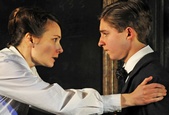SITE GUIDE
SEARCH
REVIEWS
REVIEW ARCHIVES
ADVERTISING AT CURTAINUP
FEATURES
NEWS
Etcetera and
Short Term Listings
LISTINGS
Broadway
Off-Broadway
NYC Restaurants
BOOKS and CDs
OTHER PLACES
Berkshires
London
California
New Jersey
DC
Connecticut
Philadelphia
Elsewhere
QUOTES
TKTS
PLAYWRIGHTS' ALBUMS
LETTERS TO EDITOR
FILM
LINKS
MISCELLANEOUS
Free Updates
Masthead
Writing for Us
A CurtainUp  London Review
London Review
 London Review
London ReviewThe Turn of the Screw
|
"They did things in the daylight that married couples are ashamed to do at night."
— Mrs Grose
|

Anna Madeley as the Governess and Laurence Belcher as Miles (Photo: Nobby Clark) |
The opening scene is set in the offices of the children's uncle, Sackville (Orlando Wells) where he is recruiting the Governess (Anna Madeley) to care for the children of his dead sister. Initially her charge will be the girl Flora (Lucy Morton) but soon after her arrival Flora's brother Miles (Laurence Belcher) is expelled from boarding school and comes to live at home. This rather pompous uncle becomes almost flirtatious when he offers to read the Governess's palm and she certainly sees it as a sexual advance. But any hopes as to their future involvement with a Jane Eyre type ending are dashed when Sackville makes it clear that she is not to ask him to have anything to do with the children or their upbringing. The Governess travels to Essex and is met at Bly by Mrs Grose (Gemma Jones) the housekeeper who is mysterious and evasive about how the last governess Miss Jessell died. The children have been close to many deaths, of their parents and the last governess.
Lindsay Posner has based his production on this quote from Henry James' novella in the voice of the governess. "I was there to protect and defend the little creatures in the world the most bereaved and the most lovable, the appeal of whose helplessness had suddenly become only too explicit, a deep, constant ache of one's own committed heart. We were cut off, really, together, we were united in our danger. They had nothing but me, and I — well, I had them."
Peter McKintosh's revolving set has been designed with the rooms on a level but up above a swathe of cloud, shrubs and rock breaks through the walls and tall windows to create an impression of the outside of the house, and for the audience to see what ghostly figures the Governess is seeing through the windows or up the tower. When the set revolves we can see the edge of the water, the reeds and the rowing boat.
The story depends on the ghost story gasp of the sudden appearance of the figures who are dead and the mystery is whether the children have been involved with evil or whether the governess has an overactive imagination and is sexually repressed. At one point the director has the governess touch herself when she thinks she is alone. One of the changes made is that Miles in the original is 10 years old whereas here the actor has gone through puberty and his voice has broken. Still any scenes between the governess and the boy with sexual overtones are distasteful with 21st century child abuse awareness.
Anna Madeley seems agitated and nervous as the Governess coping with these strange children but trying to give them motherly love. She does what the director asks and acts out sexual curiosity as she hears the tale of Miss Jessell (Caroline Bartleet) and her coarse lover Peter Quint (Eoin Geoghegan). She is terribly humiliated by the sexually aware Miles who says to her, "I thought all poor people wanted to marry into money,"and gropes her breasts. Gemma Jones brings normality as the kindly housekeeper. Lucy Morton, the night I saw alternate Floras, had a nicely mechanical delivery with a steady gaze and was definitely unsettling. I found Laurence Belcher's Miles creepy. There are moments when the audience instead of being chilled, laughs out loud but on the whole Scott Penrose's supernatural illusions surprise. What didn't work for me were the sexual undercurrents which will also dissuade the parents who have kept the teenage audience going to The Woman in Black.
|
Subscribe to our FREE email updates with a note from editor Elyse Sommer about additions to the website -- with main page hot links to the latest features posted at our numerous locations. To subscribe,
E-mail: esommer@curtainup.comesommer@curtainup.com
put SUBSCRIBE CURTAINUP EMAIL UPDATE in the subject line and your full name and email address in the body of the message -- if you can spare a minute, tell us how you came to CurtainUp and from what part of the country. |
| The Turn of the Screw
Written by Rebecca Lenkewicz after the novella by Henry James Directed by Lindsay Posner Starring: Anna Madeley, Orlando Wells, Gemma Jones, Laurence Belcher With Caroline Bartleet, Eoin Geohegan, Isabella Blake Thomas/Emilia Jones/Lucy Morton. Designed by Peter McKintosh Composer: Gary Yershon Lighting: Tim Mitchell Sound: John Leonard Video Design: Jack Henry James Illusionist: Scott Penrose Movement: Imogen Knight Website: www.almeida.co.uk Production sponsored by Pinsent Masons Almeida's Principal Partner is Aspen Running time: Two hours 30 minutes with one interval Box Office: 020 739 4404 Booking to 16th March 2013 Reviewed by Lizzie Loveridge based on 25th January 2013 at Almeida, Almeida Street, London N1 1TA (Tube: The Angel) |
|
REVIEW FEEDBACK Highlight one of the responses below and click "copy" or"CTRL+C"
Paste the highlighted text into the subject line (CTRL+ V): Feel free to add detailed comments in the body of the email . . . also the names and emails of any friends to whom you'd like us to forward a copy of this review. |




